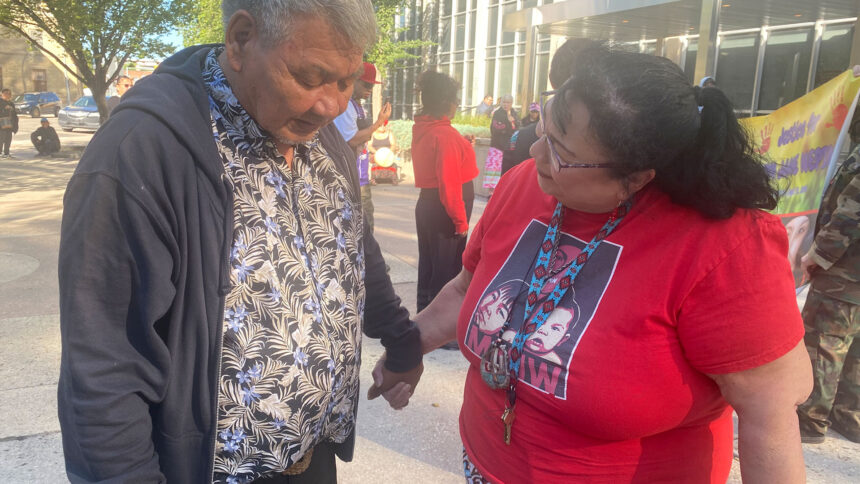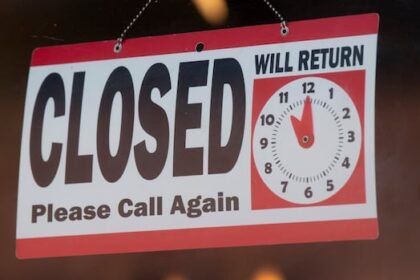Warning: This story contains disturbing content. Please read with care. The voice of Ashlee Shingoose rang out in a Winnipeg courtroom Friday as her parents delivered an emotional victim impact statement. Albert and Theresa Shingoose played a one-minute voicemail message Ashlee left on her mother’s phone before going missing in 2022. “Mom, I’m really trying my best and I will never stop trying,” Ashlee, 31, said in the recording. “I am doing this for myself, my health and my children. “And I am pregnant, and I’m afraid that if I keep on doing what I am doing it’s just, it’s all gonna go bad.” A photo of Ashlee Shingoose at a Winnipeg police news conference on March 26. Photo: APTN file The mother of two was calling from Winnipeg where she relocated with her children from St. Theresa Point First Nation in 2016 in search of a better life. “I believed in her and thought she would have made it,” Albert told Chief Justice Glenn Joyal of Court of King’s Bench. “She had a beautiful life ahead of her. “But her life was stolen from her.” Joyal agreed to hear the family’s victim impact statements even though Skibicki was convicted and sentenced last summer for killing Morgan Harris, 39, Marcedes Myran, 26, Rebecca Contois, 24, and an unknown woman between March and May 2022. Skibicki was not at the special hearing nor was he required to be. Joyal said the hearing had no bearing on Skibicki’s trial or conviction. Albert said he wished the killer was there to see and hear firsthand the pain he had caused. A missing poster in downtown Winnipeg seeks information on Ashlee Shingoose. Photo: APTN file Ashlee was not formally identified in time for the trial. But community elders wanted her to have a presence at the trial and gifted her the spirit name Mashkode Bizhiki’ikwe in Ojibwe or Buffalo Woman. She was represented by a red ribbon dress draped over a courtroom seat, a buffalo headdress, some tobacco and an eagle feather. “Today’s hearing is intended to provide the Shingoose family with the same opportunity as was provided to the families of Mr. Skibicki’s other victims,” Joyal told the nearly full public gallery. “It is an opportunity to acknowledge the dignity of Ashlee Shingoose, to acknowledge who she was, where she came from, who she loved, and what was lost with her murder.” Joyal said the hearing would not be part of the trial record but will be forwarded to the Parole Board of Canada in the event Skibicki applied for release. Skibicki is serving a life sentence for four, first-degree murders. Video: Family of woman murdered by Winnipeg serial killer read impact statements in court Crown attorney Renee Lagimodiere told court Ashlee was identified as Buffalo Woman months after Skibicki was convicted and sentenced with the help of DNA and the murderer. She said the killer identified a photo of Ashlee police showed him in prison, and DNA tested positively for him and Ashlee from a pair of leggings and a cigarette butt in his apartment. Like the other victims, Ashlee was a First Nations mother struggling in Winnipeg’s inner city. John Dubois, a worker at the Indigenous homeless shelter N’Dinewemak, confirmed he was the last person to speak to Ashlee before she went missing. “There’s a war against females and it happens every day,” Dubois said in his victim impact statement. “… It goes on on a daily basis. Anywhere they can go the predators can go.” Skibicki was one of those predators, his trial heard, as he boldly told another shelter worker at N’Dinewemak he was there to “stalk his next victim.” Left to right, Rebecca Contois, Morgan Harris, Marcedes Myran and a candle for Buffalo Woman. Photo collage: APTN file Skibicki met all of his victims at or near Winnipeg’s four main homeless shelters and lured them to his home with promises of food, substances and a place to sleep. Instead he assaulted and killed them, before sexually abusing them in death – sometimes for weeks. A psychiatrist for the Crown diagnosed Skibicki as a homicidal necrophiliac. Lagimodiere said the Crown sought the special hearing after Buffalo Woman was identified. “This explains how we ended up here,” the prosecutor said while listing statistics from the final report of the National Inquiry into Missing and Murdered Indigenous Women and Girls that ran from 2017-2019. “Indigenous women have long said the justice system has failed them. [They] are 12 times more likely to go missing or be murdered, and 16 times more likely to go missing [than non-Indigenous women].” Both Lagimodiere and Joyal said they hoped the hearing would give Ashlee’s family an outlet for their grief and sorrow. They further hoped it would show society the justice system takes violence against Indigenous women seriously. “As I have observed before, this case has sadly been emblematic of the tragedies that underlie the grim reality of missing and murdered Indigenous women and girls in Canada, particularly here in Manitoba,” Joyal said as Albert nodded in his seat. “This hearing presents this court with an opportunity to try to respond to one of the inherent challenges at the heart of this crisis – that so many Indigenous women and girls are both murdered and missing, that they simply disappear, leaving behind broken families and devastated communities.” Albert Shingoose hugs Sue Caribou, the aunt of Tanya Nepinak, before a special court hearing in Winnipeg Friday. Photo: Kathleen Martens/APTN News Albert said he was frightened and worried when Ashlee, one of his eight children, disappeared in Winnipeg. He said he made numerous trips 470 kilometres south to look for her with limited finances, quizzing strangers and asking street outreach groups for help. He said he still has no real answers for Ashlee’s son – Ashlee’s daughter died of exposure after her mom passed away – or his other grandchildren who ask him daily when Ashlee is coming home and where she is. “We are very humble. A loving, caring, understanding family,” Albert said during his victim impact statement while holding an eagle feather and surrounded by his wife, two of his daughters and the chief of his Anishinaabe community. “God says forgive. “It’s a very hard thing – very hard – when something like this happens.” Now, the family is girding up for the search for Ashlee’s remains in the city’s Brady Road landfill. Skibicki disposed of all his victims in garbage bins that were emptied and the contents trucked to two local landfills.The remains of Contois were recovered before the trial, while those of Harris and Myran were found after the trial. Manitoba Premier Wab Kinew announced earlier this week he had approved a search of the same landfill for another Indigenous woman who is believed to have been murdered by a different serial killer, Sean Lamb, in 2011. Kinew said searchers would look for the remains of Ashlee first and then Tanya Nepinak, a 31-year-old mother of two. Continue Reading
Its a very hard thing: Family of Ashlee Shingoose have their day in court

Leave a Comment










